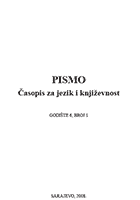Hronotop hajke u Šćepanovićevom tekstu Usta puna zemlje
Chronotope of persecution in Šćepanović’s text Mouth Full of Earth
Author(s): Tatjana BečanovićSubject(s): Literary Texts
Published by: Bosansko filološko društvo
Keywords: hajka; hronotop; kod; roman-novela; montaža; neverbalna komunikacija; fokalizacija; parabola; metatekstualnost; kompoziciona kompresija
Summary/Abstract: In Šćepanović’s novel-novella Mouth Full of Earth persecution is modeled as a universal process deeply rooted in the very essence of being, as a proto-situation adopted by every culture and repeated by the laws and logic of an archetypal paradigm. Spatial-temporal point of view is in this novel usually fixed and attached to the characters, which means that the narration, i.e. representation is mediated through their physical-existential position. In the case of the persecutioner the narrative voice matches the perspective, i.e. the one who speaks is the one who sees, which results in the homodiegetic narrative situation, whereas in the case of the persecutioned, nameless hero there is a distance and mismatch between the narrative and observing instance, which inevitably results in the heterodiegetic narrative situation. Mouth Full of Earth is an allegorical story about the persecution and discrimination of an individual in a society that cherishes a collectivity cult divinizing peasant-working mentality and axiological parameters. A hidden dialogue with the communist ideology, which in the years when Šćepanović created this text was still cherishing the collectivity cult dominating the entire Yugoslavian culture and its semiotic sphere, points to one of the metatextual dimensions of this short and dense hybrid of genres. As for the spatial structures in the novel-novella Mouth Full of Earth semantically the most complex one is doubtlessly the binary opposition that exists between the upper and lower world. The upper world is from the beginning only subtly implied, merely suggested through hierophanic symbols and Christian mysticism, especially through the elaborated imagery of stars, sky and birds, providing parallel modeling and simultaneous existence of the upper and lower world but endowing them with completely different functions. Namely, the lower world is a showground of a meaningless, futile and wasted life; it is a space and time framework within which persecution is enacted as the only possible action and the eternal, archetypal form of existing, behaving and communicating.
Journal: Pismo - Časopis za jezik i književnost
- Issue Year: 2008
- Issue No: 06
- Page Range: 342-354
- Page Count: 13
- Language: Bosnian

